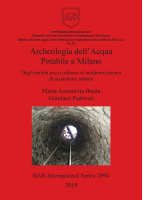Description
Il decimo libro della serie Hypogean Archaeology è dedicato alla storia dell’Acquedotto Civico di Milano (costruito a partire dal 1889) e alle architetture per l’acqua prelevata dal sottosuolo: i pozzi e le stazioni di pompaggio. L’acqua, elemento fondamentale per la vita, ha richiesto fin dall’antichità la creazione di sistemi per captarla e condurla nelle aree abitate. Il testo offre al lettore diversi spunti di riflessione per cogliere l’importanza di questo elemento e per conoscere le architetture adottate per la sua presa dalle falde acquifere profonde. Abbiamo inoltre esempi italiani di pozzi ordinari e di acquedotti antichi studiati e rilevati dalla Federazione Nazionale Cavità Artificiali (F.N.C.A.). Non mancano riferimenti a testi classici (Cesare Cesariano, Sesto Giulio Frontino, Vitruvio e altri) che tracciano un “percorso” di Archeologia dell’Acqua e introducono l’argomento principale.
The tenth volume of the Hypogean Archaeology subseries is dedicated to the history of the Civic Aqueduct of Milan (built starting in 1889) and to those architectures designed to draw water from the subsoil: wells and groundwater pumping stations. Water, the fundamental element of life, has since ancient times demanded the creation of systems to capture it and lead it to habited areas. The text offers the reader various cues for thought for understanding the importance of this element and to know the architectures adopted for its grip from the deep aquifers. Furthermore, it presents Italian examples of ordinary wells and ancient aqueducts studied and surveyed by the National Federation of Artificial Cavities (F.N.C.A.), together with a wealth of references to classical texts (Cesare Cesariano, Frontinus, Vitruvius and others) that, trace the ‘path’ of Water Archaeology, and introduces the main topic.
AUTHOR
Maria Antonietta Breda: architetto, dottore di ricerca in Urbanistica Tecnica e specialista in Restauro dei Monumenti è research fellow il presso il Politecnico di Milano - Dipartimento di Architettura e Studi Urbani. Relatrice a convegni in Italia e all’estero è autrice di circa ottanta pubblicazioni sui temi della storia e della tutela del patrimonio architettonico e paesaggistico.
Maria Antonietta Breda, architect, PhD in Urban Planning and a specialist in the Restoration of Monuments, is a research fellow at the Polytechnic of Milan, in the Department of Architecture and Urban Studies (DAStU). A speaker at conferences in Italy and abroad, she is the author of almost 80 scientific publications on the history and protection of architectural and landscape heritage.
Gianluca Padovan: speleologo, scrittore, fondatore e presidente della Associazione Speleologia Cavità Artificiali Milano (S.C.A.M.). Co-fondatore della Federazione Nazionale Cavità Artificiali (F.N.C.A.) e condirettore della Collana “Hypogean Archaeology” dei British Archeological Reports di Oxford ha promosso la nuova disciplina per lo studio e la documentazione delle Cavità Artificiali a livello internazionale. È autore di numerosi libri a carattere scientifico.
Gianluca Padovan is a speleologist, writer, and founder and president of the Associazione Speleologia Cavità Artificiali Milano (S.C.A.M.). As co-founder of the Federazione Nazionale Cavità Artificiali (F.N.C.A.) and co-director of the Hypogean Archaeology subseries of the BAR International Series, he has promoted the new discipline of the documentation of underground structures internationally. He is the author of 30 books on scientific subjects.
REVIEW
‘Dal punto di vista documentale la pubblicazione è sicuramente attendibile e bene organizzata. La documentazione è in gran parte inedita e contribuisce indubbiamente ad arricchire e ampliare il quadro delle conoscenze sulla tematica trattata.’ Ing. Maurizio Brown, MM SpA, Milano











